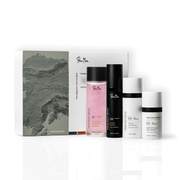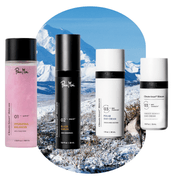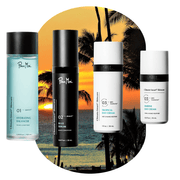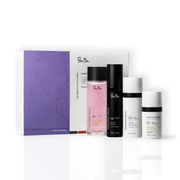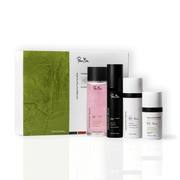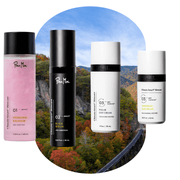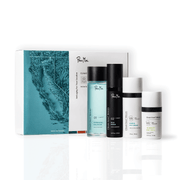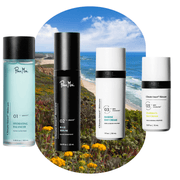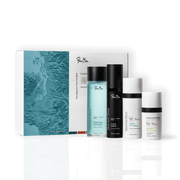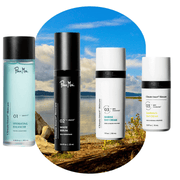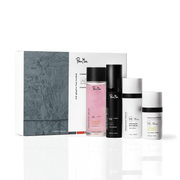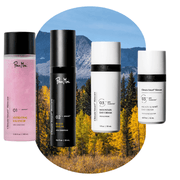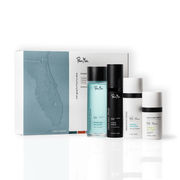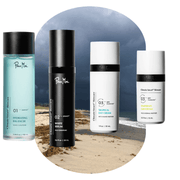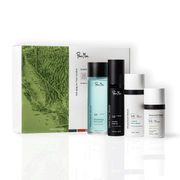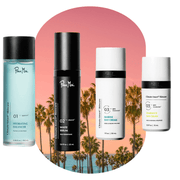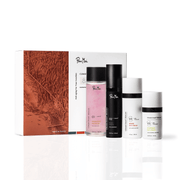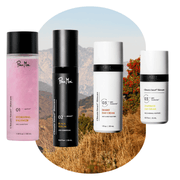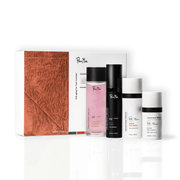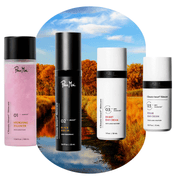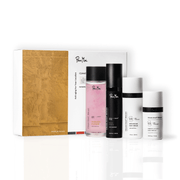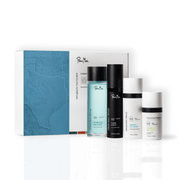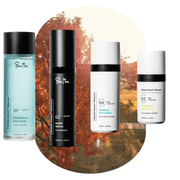20 September 2024
Ever notice how your skin often experiences breakouts and irritations when the weather changes? When these skin problem arise, however, we tend to say to ourselves “my skincare products have stopped working” not recognizing that it’s the changing seasons and the changing needs of our skin that is the real culprit.
Seasonal transitions, such as the shift from autumn to winter or spring to summer, are often the most vulnerable times for our skin. These transitional periods are when the environment changes most rapidly, and our skin has to work overtime to adapt to these rapid changes. The heightened vulnerability during these in-between seasons can manifest as various skin conditions, from dehydration and breakouts to irritation and sensitivity. [1]
Let’s explore how the skin becomes more vulnerable during these in-between times and how that vulnerability can lead to common skin issues.
Summer to Autumn: The Decline in Humidity and Rise of Dryness
As summer fades and cooler autumn breezes begin to blow, the shift in humidity levels can dry out your skin, particularly if you've been using lightweight, oil-controlling products throughout the summer hot months. The sudden decrease in moisture in the air makes this transition particularly tough on your skin's hydration levels. [2]
How Vulnerability Manifests:
- Flakiness and Dry Patches: The drop in humidity means less moisture in the air, which can lead to flaky or dry skin. If you’ve been using oil-controlling products throughout the summer, you might notice a sharp increase in dryness during this transition period. [1]
- Dullness: After basking in the summer sun, your skin might develop a rough texture as dead skin cells accumulate on the surface. This gives your skin a dull, tired appearance as autumn sets in.
How to Adapt:
- Exfoliate and Hydrate: As the weather cools, switch to more hydrating products and consider adding gentle exfoliants to slough off dead skin cells. Follow up with a moisturizer designed to reinforce the skin’s barrier.
- Prep for Cold Weather: Start layering your skincare to build up hydration. Incorporating serums and creams to give your skin a boost and help it transition smoothly into the colder months.
Autumn to Winter: The Slow Creep of Dryness and Sensitivity
As the warm autumn days fade and winter takes hold, the change in temperature and humidity can cause your skin to lose moisture rapidly. This transition from moderate to harsh cold is particularly hard on the skin's barrier, as it hasn’t fully adjusted to the extreme dryness that winter brings.
How Vulnerability Manifests:
- Dehydration: As the air becomes colder and drier, the skin loses moisture through increased transepidermal water loss (TEWL). [3] This leaves the skin feeling tight and dry, setting the stage for cracks and flakiness, especially on areas exposed to the elements, like your hands and face.
- Sensitivity and Redness: The reduced humidity makes it difficult for your skin’s natural oils to maintain the barrier function. [4] A weakened barrier means your skin becomes more sensitive to irritants and environmental stressors, resulting in redness, itchiness, and sometimes even the worsening of skin conditions like eczema or rosacea.
How to Adapt:
- Hydrate Early and Often: Start using creams designed to maximize hydration and moisture before winter hits to get ahead of dehydration. Products that can help lock in moisture and repair your stratum corneum’s barrier function are ideal.
- Soothe Sensitivity: Disruption of the skin barrier makes your skin vulnerable for environmental stressors like pollutants and allergens. Using products that help reduce inflammation and irritation while restoring your skin’s balance and protecting your stratum corneum is the first step to fighting the dry skin doldrums.
Winter to Spring: The Bloom of Breakouts and Irritation
Winter’s end may bring excitement for the warmer days ahead, but this transition can spell trouble for your skin. As temperatures rise and humidity increases, your skin might become overwhelmed by the sudden environmental shift.
How Vulnerability Manifests:
- Breakouts: After months of layering heavy moisturizers and protecting against dryness, your skin may be slow to adjust to the extra oil production that springtime brings. The increased humidity and rise in temperatures stimulate more sebum production, which can clog pores and lead to acne or blemishes. [1] [5]
- Irritation from Allergens: Spring comes with its fair share of allergens, including pollen, which can trigger contact dermatitis or worsen conditions like eczema in some people. Those with sensitive skin may experience itchiness, rashes, or hives during this time. [5]
How to Adapt:
- Lighten Up: As you move from winter to spring, consider switching to lighter moisturizers that won’t suffocate your skin as oil production ramps up. Look for non-comedogenic, oil-free products to prevent breakouts.
- Prevent Breakouts: Help reduce excess oil and keep pores clear by using products that adapt to the rising humidity. Skincare formulations with anti-inflammatory properties, can help calm skin irritation that results from environmental allergens.
Spring to Summer: The Rise of Oil and Sun Sensitivity
As spring turns to summer, rising temperatures and increased sun exposure create a whole new set of challenges. The skin, especially after adapting to milder spring conditions, can be overwhelmed by heat and UV radiation, making it more prone to sensitivity and oil imbalances.[1]
How Vulnerability Manifests:
- Oily Skin and Breakouts: The transition from mild spring days to hot, humid summer months can increase sweat and sebum production, which leads to clogged pores and more frequent breakouts. [4]
- Sun Sensitivity and Hyperpigmentation: The sudden increase in sun exposure during summer can exacerbate hyperpigmentation in those prone to dark spots or melasma. UV rays break down collagen, making your skin more prone to wrinkles and sun damage. [1] [5]
How to Adapt:
- Protect Against UV: Sunscreen is a must! Opt for a broad-spectrum sunscreen with at least SPF 30 to guard against harmful UV rays. And remember to reapply every 90 minutes if you are out in the sun or more frequently if you ae in water or sweating a lot.
- Manage Oil Production: Lightweight, gel-based moisturizers are ideal for warmer weather, as they hydrate without contributing to oil buildup. Using creams designed to balance excess sebum production that results from the ring temperatures and humidity can help to keep your complexion clear and healthy looking.
The Takeaway: Navigating the In-Between
The time between seasons is when your skin is at its most vulnerable. Rapid changes in temperature, humidity, and environmental stressors force your skin to adapt quickly, which often leads to imbalances and skin conditions.
Pour Moi Skincare is the only skincare company in the world that uses a patented rotating day cream system designed to adjust your daily routine to the changing climate surrounding you. The day creams are formulated to reinforce your stratum corneum as it battles the ever-changing weather, ensuring that your skin barrier function is protected which will keep your skin happy and healthy, no matter the season. Yes, your skin's needs will change just like the weather, but unlike the weather, using Pour Moi Climate-Smart skincare’s revolutionary cream finder technology, you never have to guess what cream to “wear” on your face!
REFERENCES
[1] Ifeanyi Uchegbulam, Simon G. Danby, Roger Lewis, Matt J. Carré, Raman Maiti,
Effect of seasonal change on the biomechanical and physical properties of the human skin,
Journal of the Mechanical Behavior of Biomedical Materials, Volume 127, 2022, https://www.sciencedirect.com/science/article/abs/pii/S1751616121006834
[2] K.A. Engebretsen, S. Kezic, C. Riethmüller, J. Franz, I. Jakasa, A. Hedengran, A. Linneberg, J.D. Johansen, J.P. Thyssen, Changes in filaggrin degradation products and corneocyte surface texture by season, British Journal of Dermatology, Volume 178, Issue 5, 1 May 2018, Pages 1143–1150. https://academic.oup.com/bjd/article-abstract/178/5/1143/6753023?redirectedFrom=fulltext
[3] Herrero-Fernandez M, Montero-Vilchez T, Diaz-Calvillo P, Romera-Vilchez M, Buendia-Eisman A, Arias-Santiago S. Impact of Water Exposure and Temperature Changes on Skin Barrier Function. J Clin Med. 2022 Jan 7;11(2):298. doi: 10.3390/jcm11020298
[4] Sophie Knox, Niamh M. O’Boyle,Skin lipids in health and disease: A review, Chemistry and Physics of Lipids, Volume 236,2021. https://doi.org/10.1016/j.chemphyslip.2021.105055
[5] J. Chen, Y. Liu, Z. Zhao, J. Qiu, Oxidative stress in the skin: Impact and related protection. Int. J. Cosmet. Sci. 43, 495–509(2021). https://doi.org/10.1111/ics.12728




